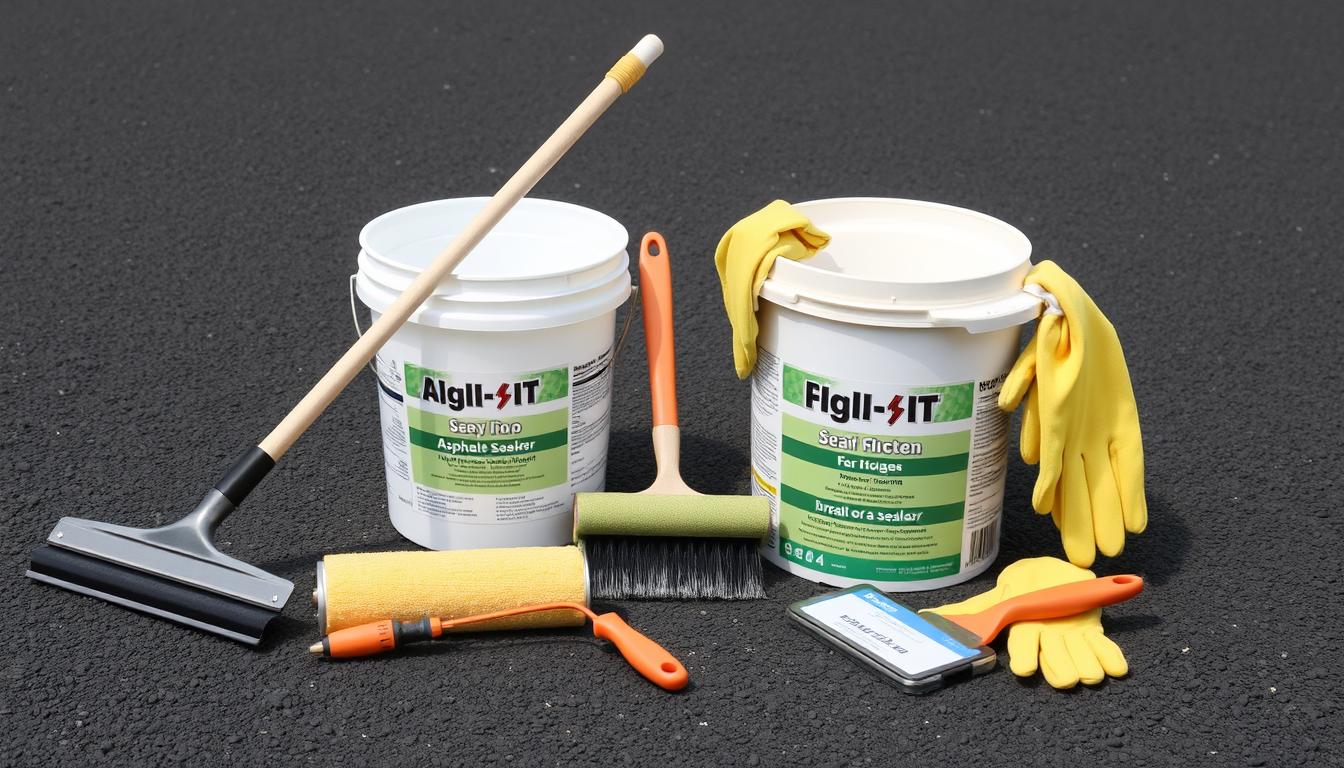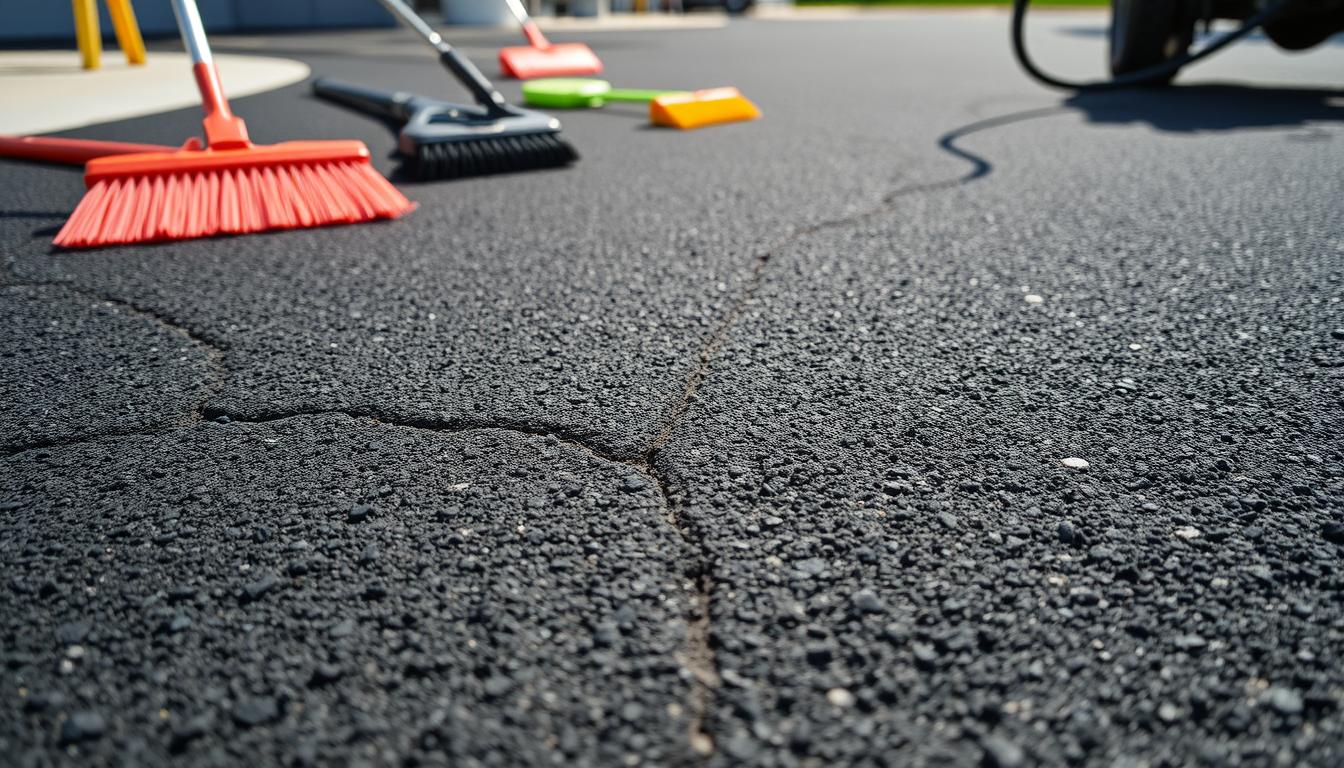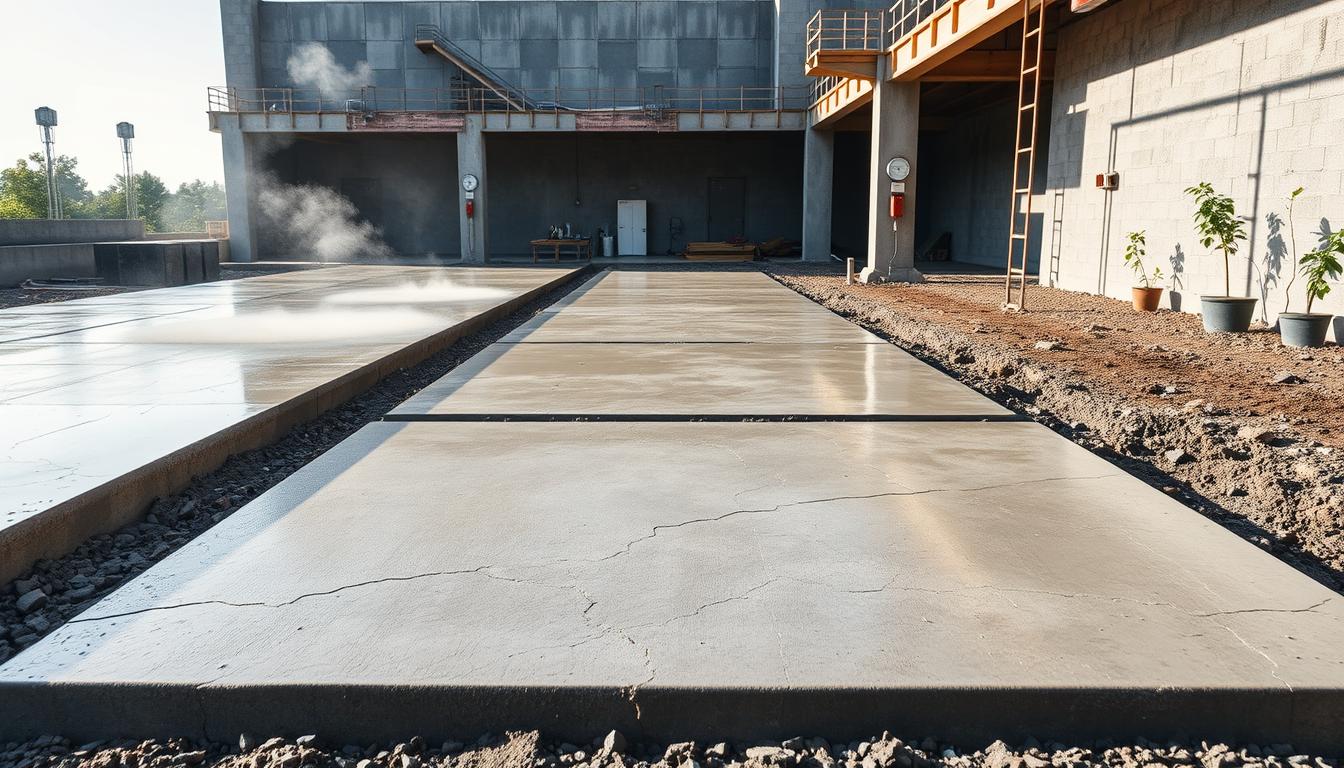Ever wondered what tools and materials are used in concrete repair? Or how small cracks in your driveway can turn into big problems? Knowing the right tools and materials for concrete repair can stop these issues. Whether it’s your home driveway or a big commercial area, the right tools and materials are key for fixing it right.
We’ll explore the different repair methods. This includes using flexible concrete caulk, bonding agents, and patching materials. These are the basics for making repairs that last. With this knowledge, you’ll be ready for any repair job that comes your way.
Key Takeaways
- Flexible concrete caulk is essential for filling cracks in exterior slabs.
- Narrow cracks can often be repaired with just a tube of concrete caulk.
- Understanding the repair approach is vital, as indoor and outdoor applications demand different materials.
- The longevity of a repair can hugely depend on the materials used and regular inspections.
- Tools vary from simple caulking guns for minor tasks to specialized machinery for larger repairs.
- Professional repairs often result in a better aesthetic finish than DIY methods.
- Crack filling is a vital maintenance practice for prolonging the lifespan of concrete surfaces.
Understanding Concrete Repair Basics
Concrete repair involves different methods to fix damage and keep concrete surfaces strong. Issues like cracks, spalling, and wear can happen due to weather or time. Spotting these problems early can save money and prevent bigger issues.
Types of Concrete Damage
Cracks and spalling are the main problems, making up 65% of all issues. Cracks come from tension or bad curing, while spalling is caused by freezing and thawing. Corrosion and buckling are other common problems. Regular checks help understand these issues better.
Signs That Repair is Needed
Spotting damage early is key to keeping concrete in good shape. Visual checks can find about 75% of damage like cracks and flaking. After fixing, keep watching for more problems, as this can cut down future issues by 40%. Knowing when to repair can save money and effort.
Overview of Repair Methods
There are many ways to fix concrete, depending on the damage. You can fix small cracks, big structural problems, or just make it look better. Picking the right method is important. Good quality control can make repairs last longer and work better, cutting down on future problems by 50%.
Knowing about repair options helps property owners make smart choices. Techniques like asphalt crack filling and advanced monitoring can greatly improve repair results. This ensures your concrete stays safe and strong for a long time.
Essential Tools for Concrete Repair
Concrete repair needs the right tools for lasting results. Chisels and hammers, trowels and floats, and concrete mixers are key. They help with everything from breaking up old concrete to applying new.
Chisels and Hammers
Chisels and hammers are must-haves for fixing concrete. Chisels remove old or damaged concrete, while hammers break down tough spots. Using these tools right makes the repair area clean and ready for new concrete.
Trowels and Floats
After prep, trowels and floats take over. Trowels spread concrete or patching compound for a smooth finish. Floats level and finish the surface, making it strong and looking good. Knowing how to use these tools is key.
Concrete Mixers
Concrete mixers are essential for mixing materials well. They mix aggregates, water, and additives for a strong mix. A well-mixed concrete ensures repairs last and don’t cause future problems.
Materials Required for Concrete Repair
Choosing the right materials is key for effective concrete repair. Knowing the different types of products helps ensure durability and strength. Concrete patching products, waterproofing agents, and reinforcement materials each have their own role in repairs.
Concrete Patch Products
There are many types of concrete patching products, like epoxy, polymer-modified mixes, and cement-based options. Each has its own benefits for different types of damage. For example, epoxy is great for fixing cracks, while polymer-modified mixes work well for filling big holes.
Choosing the right patch product depends on the damage’s extent and the repair’s goal.
Sealers and Water-Proofing Agents
Sealers and waterproofing agents are vital for lasting repairs. They keep moisture out, preventing damage and extra repairs. The right waterproofing agents can save money and make repairs last longer, based on the environment and exposure.
Reinforcement Materials
When structural strength is a concern, reinforcement materials are essential. Rebar, wire mesh, and fiber reinforcement add strength and help with weight. Using these materials with patch products ensures a solid repair, even in heavily damaged or busy areas.
Preparing the Site for Repair
Getting the site ready for concrete repair is key to a successful project. This first step includes important actions like assessing the damage and cleaning the area. It’s all about understanding the damage and making the area clean for repair.
Site Assessment Techniques
Using the right site assessment techniques is important. It helps figure out the damage’s extent. Knowing if a crack is small or big helps decide if you can fix it yourself or need a pro.
Checking the crack’s depth and width is also important. It helps you choose the best way to fix it.
Cleaning and Clearing the Area
Cleaning the area well is a big part of getting ready for repair. A clean surface helps the repair mortar stick better. Using tools like wire brushes can make it stick even more.
Cleaning properly makes sure the repair lasts longer. It’s a step that shouldn’t be skipped.
Safety Gear and Practices
When fixing concrete, safety is a top priority. Wearing gloves and goggles is a must. It’s all about creating a safe work environment.
By focusing on safety, you can avoid accidents. It’s a big part of doing the job right.
Mixing and Applying Concrete Repair Products
Knowing how to mix concrete repair products is key. The right mix is vital for effective repairs. It ensures the product works well for the job at hand.
Getting the mix just right means using the right amounts of each ingredient. This includes things like aggregates, adhesives, and additives. It’s all about blending them perfectly.
Proper Mixing Techniques
It’s important to follow the maker’s instructions when mixing. The right water-to-dry mix ratio is critical to avoid weak spots. Using tools like mixers or buckets helps mix everything evenly.
But, be careful not to mix too much. Too much air can weaken the mix. Following these steps helps the mix stick better when applied.
Application Methods
After mixing, picking the right way to apply the product is important. For small cracks, troweling works well. But for bigger areas, patching or resurfacing might be better.
For really deep cracks, using epoxy injections can seal them up. Each method needs skill to get a smooth finish. This helps prevent more repairs later on.
Curing Processes
Knowing how to cure the concrete is also key. Curing helps the concrete get strong and durable. The time needed can vary based on the product and environment.
Usually, curing takes a few hours to days. Doing it right helps prevent early drying and cracks. Following these steps makes the repair last longer and work better.
Specific Repair Techniques
Concrete repair needs different techniques for cracks, holes, and worn surfaces. Knowing each method is key for the best results. Choosing the right materials and how to apply them can make concrete last longer and look better.
Crack Filling
When filling cracks, it’s important to check their size and depth. Small cracks might just need a flexible sealant. But, bigger cracks need a backer rod and caulk.
The backer rod helps the caulk sit right. This keeps it safe from damage from people or cars walking on it.
Patching Holes and Surface Repairs
Fixing holes often means using strong products like Devcon® Floor Patch™. It’s strong and makes surfaces smooth. It’s important to cure these materials well to avoid problems.
Following the maker’s drying time is key. This helps the fix last longer.
Resurfacing
Resurfacing makes old or damaged concrete look new again. It involves adding a thin layer of special material, like Devcon® Epoxy Coat™ 7000. This makes the surface better and more attractive.
For a non-slip surface, use Devcon® Floor Grip. It has special granules. This not only looks good but also lasts longer against wear and weather.
Advanced Tools for Complex Repairs
When dealing with tough concrete repairs, the right tools are key. This section looks at advanced tools for various challenges. We focus on diamond blades, electric tools, and concrete saws. Using these tools right boosts precision and performance in repairs.
Diamond Blades
Diamond blades are vital for cutting concrete. They make precise cuts, causing little chipping or damage. They’re great for fixing structural cracks or getting areas ready for patching. Their lasting quality and effectiveness make them a top choice for pros.
Electric and Pneumatic Tools
Electric tools like grinders and drills make repairs smoother. They’re good at removing old concrete and getting surfaces ready for new material. Pneumatic tools, like jackhammers, can break up big chunks of concrete fast. Together, these tools speed up complex concrete work a lot.
Concrete Saws and Breakers
Concrete saws and breakers are essential for big damage jobs. They help cut through concrete safely and easily for big repairs. Using these tools ensures thorough and lasting fixes.
Importance of Quality Materials in Repairs
Choosing the right materials for concrete repairs is key to success. Quality materials ensure repairs stick well and last long. Bad products can cause ongoing problems and safety risks, costing a lot.
Choosing High-Quality Products
It’s important to pick certified repair products. These products are tested and meet high standards. They stick better, making repairs last longer. This means you won’t need to fix the surface as often, saving money.
Benefits of Using Certified Materials
Certified materials give you confidence in their quality and safety. They make repairs last longer, which is a smart choice. Plus, they’re often eco-friendly, keeping everyone safe during repairs.
Impact on Longevity and Safety
The life of concrete repairs depends on the right materials and following guidelines. Good materials reduce problems like early cracking. Making sure the concrete is ready to bond also helps. Investing in quality materials improves results and safety.
How HT Paving and Seal Coating Services Can Help
HT Paving and Seal Coating Services offers a variety of concrete repair services in the Bay Area. We tailor our solutions to meet your specific needs. Our team is skilled in paving, asphalt installation, and custom paver driveways for homes and businesses.
We fix cracks, patch holes, and resurface surfaces. Our work not only looks great but also makes your property last longer.
Overview of Our Services
We use professional techniques and top-notch materials for concrete repair and seal coating. Keeping your driveways and parking areas in good shape prevents expensive repairs later. We follow industry best practices to ensure a long-lasting finish.
For more information on our services, visit our site at additional details.
Why Choose Us for Your Concrete Needs
HT Paving and Seal Coating Services is dedicated to quality, safety, and customer satisfaction. We are a top choice for concrete repair needs. Our personalized service and expertise make us stand out.
For a consultation, call us at (415) 774-6424. Let us improve your property with durable, professionally paved surfaces.








